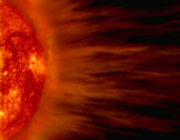solar wind
The solar wind is a tenuous, radial flow of gas and energetic charged particles, mostly protons and electrons, from the Sun's corona. The expanding solar wind also drags the solar magnetic field outward, forming the interplanetary magnetic field (IMF). The region of space in which this solar magnetic field is dominant is called the heliosphere.
 |
Although the solar wind moves out almost radially from the Sun, the rotation of the Sun gives the magnetic field a spiral form (like that of the water jet from a two-way rotating garden sprinkler). The solar wind produces aurorae, causes the tails of comets to stream back from the Sun, and distorts the symmetry of planetary magnetospheres. Its speed varies widely, from a low-speed wind over coronal streamers of (at Earth's distance) about 300 kilometers per second, to a high-speed wind, flowing from coronal holes, of 800 kilometers per second. These high and low speed streams interact with each other and alternately pass by Earth as the Sun rotates. These wind speed variations buffet the Earth's magnetic field and can produce storms in Earth's magnetosphere.
Among space probes to have observed the solar wind and variations in it are Ulysses and the Advanced Composition Explorer.


